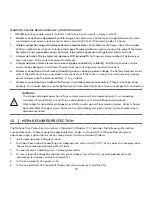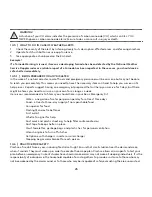
14.5 | WHAT TO DO IN CASE OF WEATHER ALERTS
1. Check the severity of the alert by listening closely to its description, affected areas, and lifesaving directives.
2. Operate test/hush button or use app to silence.
3. Take appropriate action based on the EAS alert.
Example!
If a Tornado Warning is issued, it means a developing tornado has been detected by the National Weather
Service Doppler radar or a reliable report of a tornado has been reported. In these cases, you should seek a
safe shelter immediately.
14.5.1 | BEING PREPARED FOR ANY DISASTER
In the wake of a natural disaster, local officials and emergency personnel will be on scene but may not be able
to reach you immediately. This means you need to have the necessary items on hand to help you survive until
help arrives. Experts suggest having an emergency kit prepared that will help you survive for 3 days, but there
might be times you need to survive on your own for as long as a week.
Here is our recommended list of items you should have in your basic Emergency Kit:
14.6 | PRACTICE FIRE SAFETY
Practice a fire drill twice a year, including fire drills at night. Ensure that small children hear the alarm and wake
when it sounds. They must wake up in order to execute the escape plan. Practice allows all occupants to test your
plan before an emergency. Current studies have shown smoke alarms may not wake all sleeping individuals. It is the
responsibility of individuals in the household capable of assisting others to provide assistance to those who may
not be awakened by the alarm sound, or to those who may be incapable of safely evacuating the area unassisted.
25
• Water – one gallon of water per person per day for at least three days
• Food – at least a three-day supply of non-perishable food
• Can opener for food
• Flashlight and extra batteries
• First aid kit
• Whistle to signal for help
• Dust mask and plastic sheeting, to help filter contaminated air
• Duct tape to keep shelter in place
• Moist towelettes, garbage bags, and plastic ties for personal sanitation
• Wrench or pliers to turn off utilities
• Cell phone with chargers, inverter or solar charger
• Sleeping bag or warm blanket for each person
WARNING!
Actuation of your CO alarm indicates the presence of carbon monoxide (CO) which can KILL YOU.
NEVER ignore a carbon monoxide alarm. Failure to do so can result in injury or death.







































